Award Holder: Lauren Doughton
University: University of Manchester
Title of Research: The Social Archaeology of Early Prehistoric Shetland
Hot Stuff! Embodied engagements at a burnt mound site in Shetland.
Background
Burnt mounds are prehistoric monuments found commonly throughout Britain, Ireland, Scandinavia and much of Europe. They consist of mounds of discarded stone that have been heated and placed into water. While numerous interpretations of these sites have been forwarded, two narratives, that of cooking, and that of the prehistoric sauna dominate the literature (see Barfield & Hodder 1987, Moore & Wilson 1999, O’Drisceol 1988, O’Kelly 1954 and numerous papers in Buckley 1991 and Hodder and Barfield 1991 for an illustration of this trend).
While neither of these arguments are without their merit, they present a fundamental problem in the treatment of burnt mounds thus far. The primary concern for these sites has been to find a definitive use for the technologies that they represent. Their contribution to the understanding of prehistoric life is reduced to little more than a series of dots on a distribution map (Barber & Russell White 1991:51).
Given the current focus on the dynamic social relationships between people, places and things in the past, burnt mound studies can be seen to lag behind in its continued focus on technologies as a primarily adaptive tool. This study aims to overcome the objectification of these sites by studying them not as a number of potential outcomes, but rather as a series of interlinking and transformative processes, through which people, places and things combine.
Following on from the work of writers such as Ingold (2000) this study focuses centrally on the concept of the habitus (as defined by Bourdieu, 1977), and recognises the need for a construction of a practiced-based interpretation of these sites. In particular it recognises the need to look beyond site typologies to the social processes of construction and use (as per Richards 2004). By examining the processes involved in their creation and use through a series of experimental firings the study aims to gain a greater understanding of how materials, landscape and people not only influence what it is possible to achieve through hot-stone technologies, but also how the materials, landscapes and people involved in them may have interacted with and been perceived by both those inside and outside of the process itself.
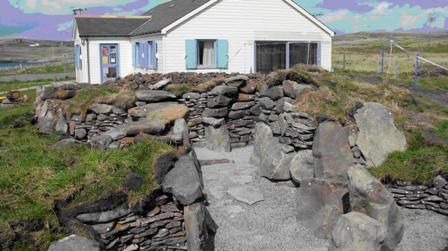
Image 1: Structures from the reconstructed burnt mound site on Bressay, Shetland.
Shetland has proved to be an ideal location to create a contextual study of burnt mounds. As well as possessing a large number of recorded sites (there are 30 known in Fair Isle alone), there has been a substantial amount of background survey done, particularly in relation to sites under risk from coastal erosion. An innovative thermoluminesence dating program has been implemented (Anthony 2003) meaning that an unusual number of dates exist for the mounds on the island, and detailed excavation has been carried out at two sites which have revealed substantial and unusual structures (Moore and Wilson, 1999, 2001, 2008). The replica site on Bressay was constructed as part of Historic Scotland’s ‘Adopt a Monument’ scheme, after the original site at Cruester was excavated as part of the Scottish Coastal Archaeology and the Problem of Erosion (SCAPE) Project. Perceiving the site to be at continued risk from coastal erosion following the initial excavation, local residents moved to adopt the site, fully excavate it, and reconstruct it at a site further up the coastline where it could be preserved as a local attraction (www.shorewatch.co.uk/cruester).
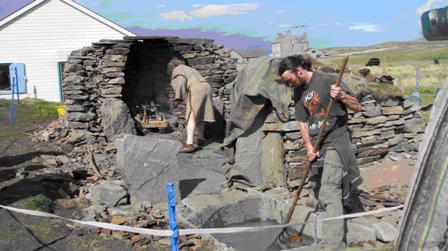
Image 2. The replica hearth, side cell and tank
As part of this process a replica tank, hearth and cell structures were also constructed nearby, with the intention of providing a venue for further research into the function and use of burnt mound sites. These replicas were constructed using the exact proportions of the original, which provides a unique opportunity to explore the affordances which hot stone technologies provide within a spatially accurate setting.
The Experimental Firings.
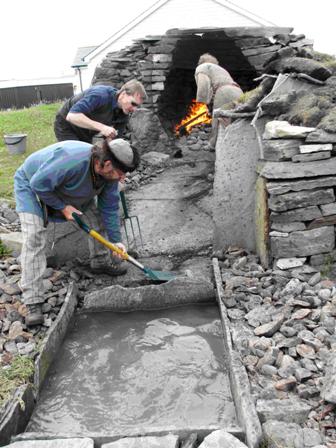
Image 3: Transporting stones from the hearth to the tank
Set within a phenomenological framework, the experiments aimed to explore how the different possible outcomes of hot stone technologies were linked through a set of shared practises, and how these practises related to other aspects of life in prehistoric Shetland, and informed and related to wider cosmologies. The experiments explored different aspects of burnt mound usage, including cooking, fleece working and dying, hide production, steam bending and brewing. Through these experiments it has been possible to explore not only the possible limitations of hot stone technology, but how use of these sites takes place within an embedded local network. The author worked closely with a number of local volunteers, as well as specialist craftpersons to carry out the activities on site.
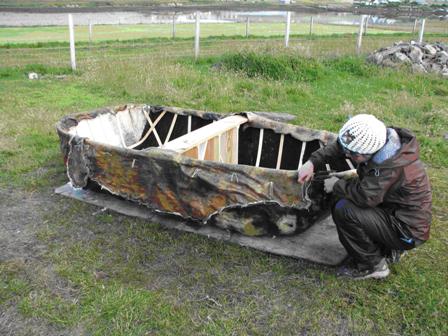
Image 4: Sewing the final skins onto the hide boat.
In total 6 different experimental activities were conducted at the replica, with some of these requiring multiple firings over subsequent days to complete the process. Fieldwork was undertaken over two seasons, and each experiment was repeated during the second season to allow for development of skill and experience following initial experiments. The exception to this was experiments relating to skin working. This process involved working multiple skins to constructed a small hide boat similar to a curricle or currach. As this process was more involved and time consuming than the others, and required the input of individuals with specialist skills, these processes were carried out successively over a period of a week during the first field season. Experimental activities included cooking, washing and dying fleece, the creation of a skin boat through cleaning and stretching of hides, and heat bending wood to create the frame, brewing using a hot rock mash technique, and a winter firing to test the viability using the structure during colder periods.
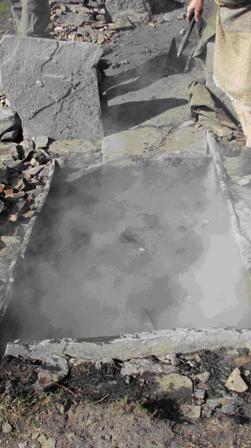
Image 5 : Steam rising from the water in the tank
Initial experiments set out to establish a method of working the mound which allowed the stones to be heated and added to a tank full of water in order to raise its temperature to a level which would allow the above processes to be carried out. These experiments established the fundamental skills and relationships that would inform most of the work at the burnt mound site. Evidence suggests that Shetland’s current treeless state was already well established by the Bronze Age (Butler 1998), while peat encroachment was an increasing factor affecting Bronze Age land use. Samples of plant rhizomes found from hearth contexts at Tangwick suggest that peat was utilised as fuel at some burnt mound sites, while the presence of large spruce logs at Stanydale suggests that driftwood formed an important part of the island economy. Peat and wood fuelled fires possess different properties, wood fires burn fast and hot, while peat fires produce a slower, but more sustained burn.
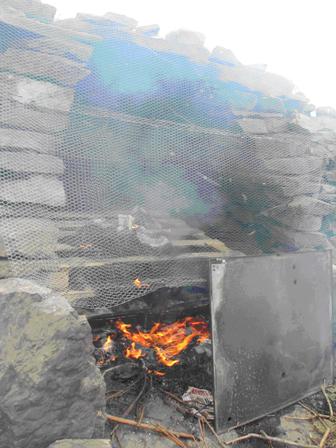
Image 6 : A fire in the replica hearth cell
As later experiments revealed, the ability to control the length and heat of the fire has a substantial effect on the types of activity it is possible to carry out. The shape of the hearth cell at Cruester meant that when a strong fire was burning within it, it became too hot to remove stones, or add new ones without being in danger of being burnt. In these instances the hearth behaved in a manner similar to a furnace, creating vast amounts of heat within a confined space. It was found to be necessary to wait until the fire had burnt itself down before the stones were removed and added to the tank, which meant although it was possible to raise the initial temperature of the water quickly and rapidly, it was then necessary to re-build the fire in order to heat any subsequent stones. While this process proved to be efficient for some processes, such as skin working, where the hides only required brief heating to render them supple and workable, it proved to be more problematic during processes such as cooking, where high temperatures were required over a sustained period of time. For this reason, despite it being one of the most common interpretations for burnt mound sites, of all the experiments undertaken at Bressay during the period of fieldwork, cooking was the only function it was not possible to replicate with any degree of success.
Sensory Engagements with Materials
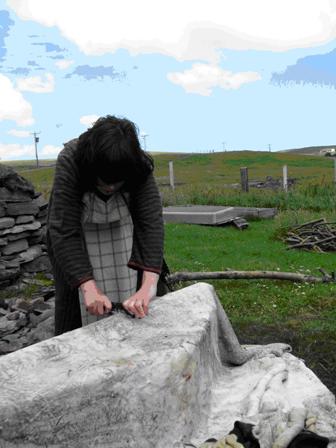
Image 7: The author scraping fat from cow hide in preparation for use on the skin boat
One of the most illuminating and rewarding aspects of this fieldwork has been the opportunity to illustrate the sensory engagements that are involved with working a burnt mound site. Each process undertaken comes with its own set of sounds, smells and sensations that set it apart from other practises, whilst at the same time sharing a sensory vocabulary common to all practises which were carried out on site. While the smell of wood or peat smoke, the extreme heat and sometimes violent cracking and popping of the fire, and the hissing scream that the stones make upon hitting the water were common to all practises, each practise had its own particular set of smells and sensations. Brewing produced a series of pleasant smells – slightly scorched grain as it came into contact with hot stones and a sweet porridgey smell as the starches began to convert to sugars, while hide working produced a series of quite different odours – the ripe smell of freshly skinned carcasses, the even riper smell of one left for a few days, and the clinging, acrid smell of rancid fat that permeated clothing and skin for weeks after the experiments had taken place. Each experience also had its own unique tactile qualities – nettles used for dying fleece required cautious handling, hot stones melted shoe soles and scorched materials, brewing left a sticky sugary residue while fat from calf skins created a greasy film over everything and everyone it came into contact with.
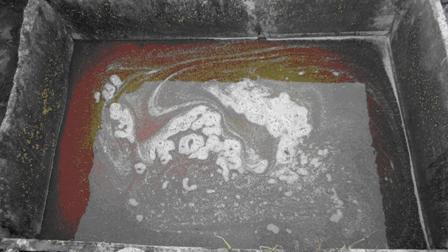
Image 8: Sticky sweet wort and grain residue in the tank (courtesy Merryn Dineley)
Each experience presented its own set of challenges that required us to rethink the way in which we engaged with the site and the materials required to work it. While it was not the aim of these experiments to replicate these processes using ‘authentic’ methods, allowing us to overcome these challenges using modern technologies (metal gardening tools to move hot stones, buckets and hosepipes for filling and bailing the tank, and plastic fermentation containers for brewing the beer), each of these processes required an engagement with the properties of materials, and an awareness of the challenges that they would present both to our modern day selves, and to practitioners in the past.
Networks of Practise and Skill
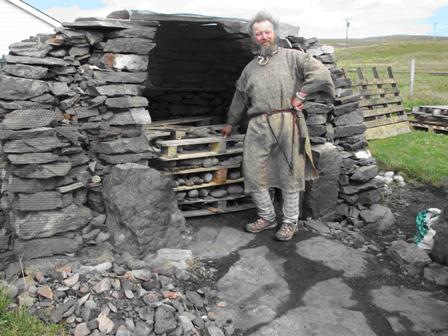
Image 9: Constructing the fire before a burn
As well as illuminating the sensory experience of working with burnt mounds this fieldwork has been able to begin to unpick some of the complex networks of people and materials that make up these technological practises. Working with groups of volunteers throughout both seasons of fieldwork a community of practise began to form around the site, based on a shared set of experiences and skills developed as a result of these experiments. A core team of burnt mound regulars developed the specific skills required for the everyday working of the mound, in areas such as how to build the fire so that the stones were properly contained for roasting, the best way to transport hot stones from the hearth cell to the tank, or where to find the raw materials for use within the tanks. Outside of this local network, further links were made, for example with local landowners to source stones for the firing, with crofters and slaughterhouses for fleece and animal hides, and with other local companies for sources of fuel, grain, wood and other materials. Links were also made with local craftpersons, brewers, and living history practitioners which allowed the sharing of skills and specialised knowledge during the firings.
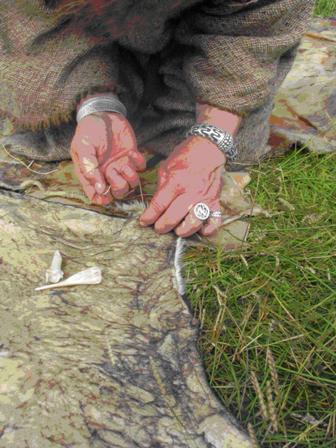
Image 10: Expert hands sew the hides together.
Each of these connections served to illustrate the wide reaching links and resonances that burnt mound usage would have had within wider prehistoric networks. By exploring these processes of procurement and exchange in a modern context, it has become possible to illustrate how by focussing solely on the output of burnt mounds and hot stone technologies (be that as a sauna, cooking site, or other industrial output), we are overlooking the wide ranging impacts that their usage would have had throughout the local community, whether that be by gathering stones from the local foreshore, or field, storing up driftwood, cutting peat banks, gathering plant materials, cultivating grain or rearing animals in preparation for slaughter. From each of these practises a chaîne opératoire can be created, and each of these can be linked together to form networks of practise and skill that spread far beyond burnt mound usage into other aspects of life in Bronze Age Shetland, and to wider understandings of Bronze Age cosmologies in general
Re-examining Bronze Age Shetland.
Not only have these experiments been instrumental in exploring how technological practises take place within wider embodied networks of skill and knowledge, they have also bee instrumental in re-examining how the prehistoric material of the Shetland Islands is viewed in light of wider Scottish, British and European practises. The Bronze Age of Shetland has been described as a period of isolation and stagnation, in which the islands inhabitants struggled against increasingly difficult climatic situations to continue to work within their landscape (Kaul 2011: 48). By engaging with burnt mounds and the processes involved in their creation and use, and has been possible to illustrate that this is not necessarily the case, and that the islands were involved in a set of activities which enmesh with a wider set of bronze age practises and belief systems (Doughton, forthcoming). Fieldwork undertaken at the replica burnt mound site in Bressay has been instrumental in exploring some of these links, allowing the prehistoric material of Shetland to be placed within a wider context.
As one of the most common prehistoric monuments recorded in Scotland, burnt mounds have been long overdue for theoretical reconsideration. It is hoped that not only will this fieldwork help to illustrate some of the outdated attitudes to technology and practise which have plagued our understanding of these sites and the use of hot stone technologies for the past three decades, and elucidate some of the links between technological practise but that it will also wider cosmological understandings in the Bronze Age, and contribute to a better understanding of life in prehistoric Shetland, and its interactions with the wider world.
Bibliography
Barber, J & Russell White, C. 1991. Introduction to the ‘Scottish Selection’ in V. Buckley, Burnt Offerings: International Contributions to Burnt Mound Archaeology. Dublin: Wordwell
Barfield, L. & M. Hodder. 1987. Burnt Mounds as Saunas: An Exercise in Archaeological Interpretation. Antiquity 61, 370-379.
Bourdieu, P. 1977 [2008] Outline of a Theory of Practice. Cambridge: Cambridge University Press.
Buckley, V. (ed.) 1991. Burnt Offerings International Burnt Mound Conference. Dublin: Wordwell.
Doughton, L. forthcoming. Burnt Mounds: Transforming Space and Place in Bronze Age Shetland. In D. Mahler (ed) Short Papers from the Northern Worlds Project Symposium – The Border of Farming – Shetland and Scandinavia, Sept 2012. Danish National Museum: Copenhagen
Hodder & Barfield (eds) 1991. Burnt Mounds and Hotstone Technology. Dublin: Wordwell.
Ingold, T. 2000. Perception of the Environment: Essays in livelihood, dwelling and skill. London: Routledge.
Kaul, F. 2011. Early Agriculture at the Border, in D Mahler & A Andersen (eds) Farming on the edge: Cultural Landscape of the North. Short Papers from the network meeting in Lerwick, Shetland, Sept 7th – 10th 2010. Copenhagen: The National Museum of Denmark. 44-57
Moore, H & Wilson, G. 1999. Food for Thought: A Survey of the Burnt Mounds of Shetland and Excavations at Tangwick. PSAS 129. 203-37.
O’Drisceoil, D. 1988. Burnt Mounds: Cooking or Bathing? Antiquity 62, 671-680.
O’Kelly, M. J. 1954. Excavations and Experiments in Ancient Irish Cooking-Places. Journal of the Royal Society of Antiquaries Ireland. 84. 105-55
Richards, C. 2004. Labouring with Monuments: Constructing the Dolmen at Carreg Samson, South-West Wales in V Cummings & C Fowler The Neolithic of the Irish Sea: Materiality and Traditions of Practice Oxford: Oxbow
Online Resources
SCAPE – Bronze Age Bressay! www.shorewatch.co.uk/cruester. Accessed 31/01/2013, website no longer working. Alternative site: https://scapetrust.org/bronze-age-bressay/, accessed 22/10/2024.
